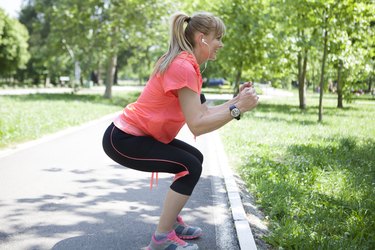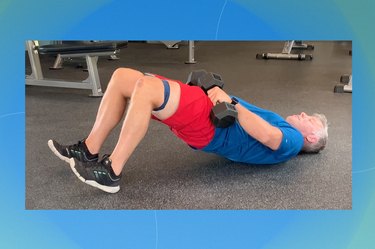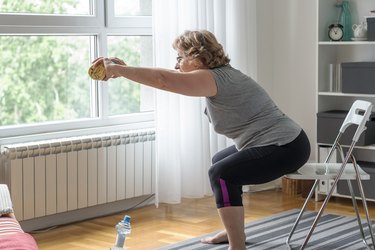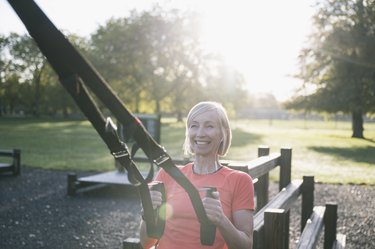
There's no denying that our bodies change throughout our lives (sometimes for the better!), and that what felt good when we were 25 might not feel so good when we're 65.
But do you need to stop (or start) doing certain things when you hit a certain age?
Video of the Day
Video of the Day
Train for Your Fitness Level, Not Your Age
What exercises you do and don't do should depend way more on your overall health and training age (how long you've been working out consistently) than your chronological age (how many years you've lived).
After all, it's totally possible to be stronger and have more endurance at 65 than 25, says Christian J. Thompson, PhD, associate professor of kinesiology at the University of San Francisco.
Think about it this way:
Maybe you picked up an exercise habit 10 years ago. Your training age is 10, and you're probably feeling pretty fit. So work out like it and advance your routine as it feels comfortable. There's nothing saying now's not the time to start training for your first marathon or rock your first pull-up.
Picked up exercise a year ago? Treat your body like you have a training age of 1 and focus on the fundamentals. Master proper technique doing body-weight and dumbbell exercises. Do low-intensity cardio. The more training time passes, the readier you'll be to move on from beginner workouts to intermediate and advanced ones.
Whatever your training age (and chronological age), a healthy exercise routine is about listening to your body and caring for however it is in that moment.
Yes, You Can Get Fitter At Any Age
"Even people in their 90s can gain muscle mass, strength and power," Thompson says. "We know the training adaptations can occur at essentially any age, and at about the same sort of pace."
The key to getting fit as you age is to keep challenging yourself. In the end, to strengthen your muscles or improve your heart health, you have to first stress the system.
Prioritize exercise that feels challenging, but doable. For example, when you're strength training, he suggests doing exercises and using weights that start to challenge you by the sixth rep — but allow you to keep good form.
Your Complete Guide to Exercise for Healthy Aging
Keep Up Your Routine (and These 4 Tips in Mind) When Exercising After 50
As we age, the best way to keep doing the things we love is to never stop doing them in the first place, explains Ashley Fluger, CSCS, an exercise physiologist at the Hospital for Special Surgery in New York City.
But it doesn't hurt to be aware of some things that you might need to consider that you might not have thought about in your 20s.
1. Be Smart About High-Impact Moves
High-impact exercises like running and jumping can effectively strengthen your bones and build muscular power (which is vital to healthy aging). But the likelihood of joint issues and arthritis also goes up with age.
"There's definitely is a place for impact, but how you program that is so specific to each person," Fluger says.
Pay attention to how your body reacts to high-impact and plyometric exercises and, if you're new to them, ease in slowly with one set per week. That will give your body the opportunity to recover and grow back stronger.
Related Reading
2. Prioritize Recovery
As you age, you may find you need to be more intentional about workout recovery, Thompson says.
"Inflammation is something that tends to ramp up quite a bit as we get older, so we need to spend time with good recovery strategies," he adds. That means listening to your body and getting adequate rest in between workouts, but also incorporating active recovery techniques like foam rolling into your routine. And don't forget about sleep — it plays a key role in recovery.
This doesn't mean you need to necessarily take more time off or draw out your recovery, Thompson says. You just need to actually do it. Prioritizing recovery strategies is something you should do your whole life, it's just easier to get away with skipping when you're younger.
Related Reading
3. Get More Protein
One pivotal piece to the workout recovery process is protein. And your body actually needs more recovery-fueling protein as you age.
Muscle tissue becomes less responsive to protein over the decades, according to a June 2016 Nutrients review, which partly explains why we lose muscle mass as we age.
A landmark January 2015 study in American Journal of Physiology – Endocrinology and Metabolism found that by eating 1.5 grams of protein per kilogram of their body weight each day, older adults can significantly improve their muscle health. For a 180-pound adult, that comes out to 123 daily grams of protein.
Related Reading
4. Focus on a Balanced Exercise Routine
"It's important as people get older to really adopt more of a 'jack-of-all-trades' sort of perspective to exercise training," Thompson explains. "It's OK when we are younger to specialize in one thing, but as we get older, we can't really afford to be a one-trick pony anymore."
So, maybe you still want to focus on distance running, but it's even more crucial to make sure you're also working resistance training, flexibility, balance, and power training into your routine, too.
"All of those things really need to come together in a person's training program so there's no weak link. As we get older, the weak link is what will break the chain," Thompson says.
Keeping that chain strong from end to end is what will keep you feeling as good — if not better than — you did in your 20s.
Related Reading
- Nutrients: "Protein Consumption and the Elderly: What Is the Optimal Level of Intake?"
- American Journal of Physiology – Endocrinology and Metabolism: "Quantity of dietary protein intake, but not pattern of intake, affects net protein balance primarily through differences in protein synthesis in older adults"




